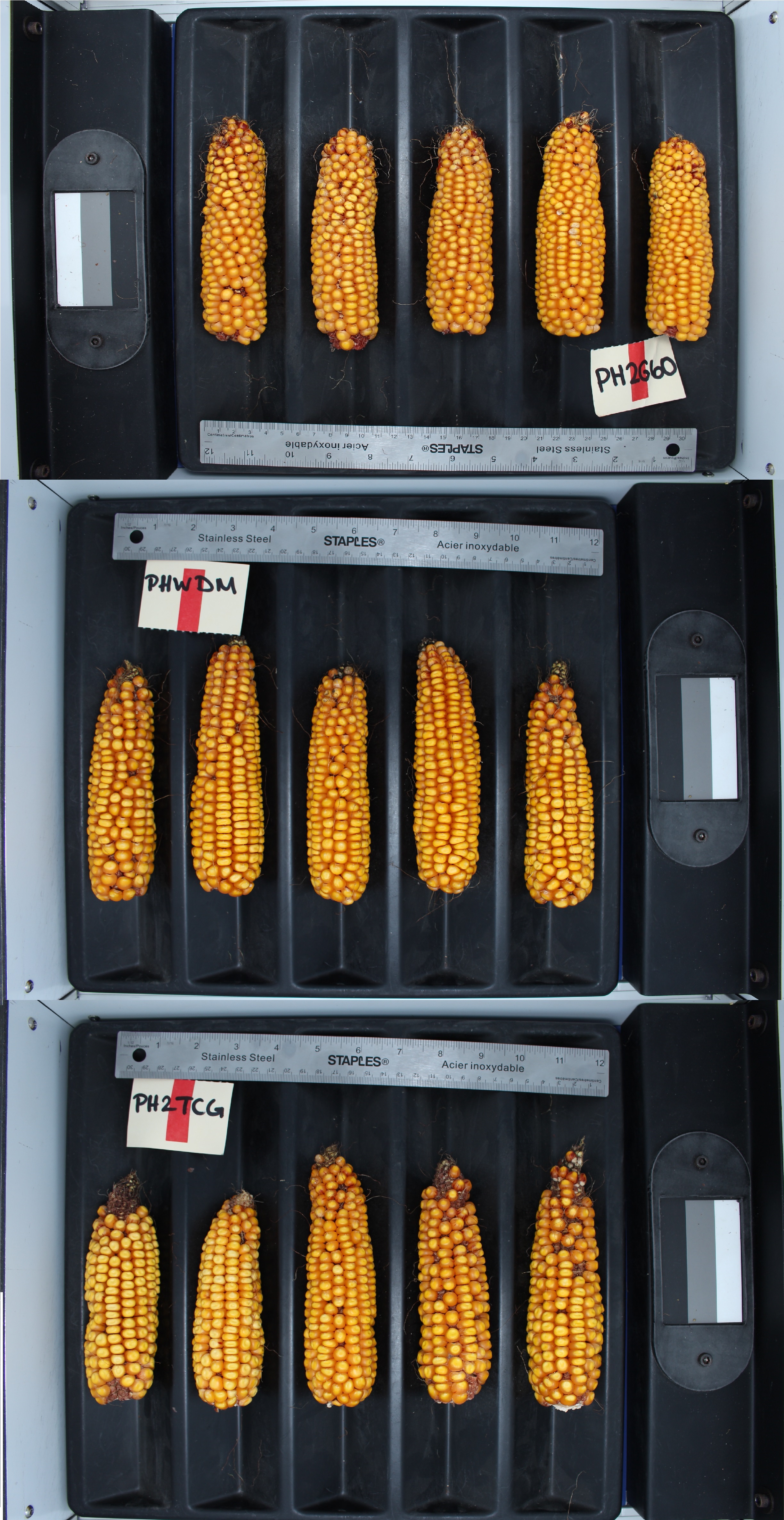PH2TCG
| Denomination: | 'PH2TCG' |
|---|---|
| Botanical Name: | Zea mays |
| Applicant/Holder: |
Pioneer Hi-Bred International, Inc. 8305 NW, 62nd Avenue P.O. Box 7060 Johnston, Iowa 50131 United States of America |
| Breeder: |
Suzanne Mickelson, Pioneer Hi-Bred International, Inc., Janesville, United States of America Edwin Grote, Pioneer Hi-Bred International, Inc., Johnston, United States of America |
| Agent in Canada: |
Pioneer Hi-Bred Production Co. 240, 115 Quarry Park Road SE Calgary, Alberta T2C 5G9 Canada Tel: 403-440-2988 |
| Application Date: | 2017-04-21 |
| Provisional Protection:: | 2017-04-21 |
| Application Number: | 17-9183 |
| Grant of Rights Date: | 2019-12-23 |
| Certificate Number: | 6110 |
| Grant of Rights Termination Date: | 2039-12-23 |
Variety Description
Varieties used for comparison: 'PHWDM' and 'PH2G60'
Summary: During anthesis, the intensity anthocyanin colouration at the base of the glume of 'PH2TCG' is weak whereas it is absent or very weak at the base of the glume of the reference varieties. The anthocyanin colouration at the tip and glume body of 'PH2TCG' is of weak to medium intensity whereas it is of medium to strong intensity at the tip and glume body of 'PHWDM'. The intensity of anthocyanin colouration of the anther of 'PH2TCG' is very strong whereas it is strong on 'PH2G60' and weak on 'PHWDM'. The tassel of 'PH2TCG' has a few to a medium number of lateral branches whereas the tassel of 'PH2G60' has none or very few lateral branches. The silks emerge mid to late season for 'PH2TCG' while the silks emerge early for 'PH2G60'. The intensity of anthocyanin colouration of the silks of 'PH2TCG' is absent to very weak whereas it is strong in'PH2G60'. The tassle of 'PH2TCG' has a medium density of spikelets whereas the tassel of 'PHWDM' has moderately dense spikelets and the tassel of 'PH2G60' has moderately dense to very dense spikelets. When including the kernels, the diameter at the middle of the ear of 'PH2TCG' is larger than that of the reference varieties.
Description:
PLANT: inbred yellow corn variety, absent to low frequency of plants with ear wings
TASSEL: anthesis occurs mid-season, large angle between main axis and lateral branches during anthesis, medium density of spikelets, very long main axis above lowest lateral branch, medium to long main axis above highest lateral branch
LATERAL BRANCHES: few to medium number on main axis of tassel, slightly recurved
GLUME: weak intensity of anthocyanin colouration at base, weak to medium intensity of anthocyanin colouration at tip and on body
ANTHER: very strong intensity of anthocyanin colouration
EAR: mid to late season silk emergence, absent or very weak intensity of anthocyanin colouration of silks, medium length husk (extends one quarter length of ear above tip), conico-cylindrical shape, very short ear wings, weak to medium intensity of anthocyanin colouration of cob glumes
KERNEL: dent-like type, yellow on top and dorsal side
Origin & Breeding History: 'PH2TCG' was developed by Pioneer Hi-Bred International, Inc. from the cross between proprietary inbred lines made in 2009 in Arica, Chile using a double haploid plant breeding method. The F1generation underwent a haploidization process in Arica, Chile in 2010. The haploid were doubled, self-pollinated and ears were harvested in 2010. From 2011 to 2013, the subsequent D1 to D3 generations were self-pollinated and harvested in bulk. Selection criteria used in the advancement process included yield per se, yield in hybrid combination, tassel size, pollen production, stalk lodging resistance, late season plant health, grain quality, as well as disease and insect resistance. Yield trials were grown in Janesville, Wisconsin, USA and wide area testing was done in Canada and the USA from 2011 to 2012.
Tests & Trials: The comparative trial for 'PH2TCG', conducted in Woodstock, Ontario during the 2017 growing season, was planted in a complete randomized design and consisted of 3 replicates. Plots consisted of one row 3 metres in length with a row spacing of 76 cm. Each plot had approximately 20 plants per replicate for a total of 50 to 60 plants per variety. Measured characteristics were based on a minimum of 29 measurements. Mean differences were significant at the 5% probability level based on unpaired Student's T-tests. Results were supported by the official technical examination report 201700165, purchased from the Plant Variety Protection Office, Beltsville, Maryland, USA.
Comparison table for 'PH2TCG' with reference varieties 'PHWDM' and 'PH2G60'
Ear diameter (in middle including kernels) (cm)
| 'PH2TCG' | 'PHWDM' | 'PH2G60' | |
|---|---|---|---|
| mean | 4.16 | 3.87 | 3.85 |
| std. deviation | 0.17 | 0.20 | 0.18 |
Click on image for larger view

Corn: 'PH2TCG' (bottom) with reference varieties 'PHWDM' (centre) and 'PH2G60' (top)
- Date modified: